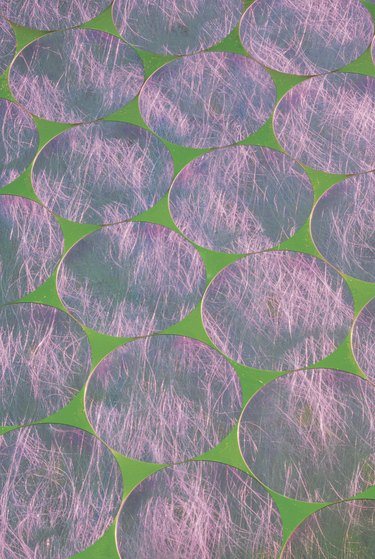
Aluminum and charcoal-based filters are used to filter and clean the air that circulates through homes and businesses. Both types of filters remove airborne contaminants and enable furnaces to operate efficiently and effectively. Aluminum filters use electrostatic principals to trap contaminants. Standard fiberglass filters contain charcoal inside to trap contaminants and clean the air. The key differences between aluminum and charcoal-based filters center on cost, convenience and performance.
Charcoal
Video of the Day
The most common type of filters used in homes contain charcoal enclosed within fiberglass. The charcoal serves as the active ingredient. It captures the dirt and dust and purifies the return flow of air that is re-circulated by the HVAC system back into the home. Charcoal-based filters come in flat panel and pleated panel varieties, with thicknesses of one, two or four inches. Thicker filters provide additional filtration. However, homeowners should only use the appropriate thickness for their furnace, according to what is recommended in their HVAC manual. Using too dense a filter can impair the efficiency of the furnace unit. Fiberglass filters are good at trapping large particles but not as effective at smaller particles, unless they are HEPA fiberglass filters. Disposable filters should be checked every month to see if they need to be replaced.
Video of the Day
Aluminum
Aluminum "electrostatic" filters are used in homes and businesses. They have an aluminum mesh screen, which is called the filter "medium." The aluminum generates an electrostatic charge when air from the furnace moves across the filter, hence the term "electrostatic" -- although no electricity is needed for the filter to operate. These filters capture dust particles and trap them to the aluminum screen. Aluminum filters are categorized as reusable because they can be removed, cleaned and reinstalled. Aluminum electrostatic filters are typically one-inch thick. High-quality aluminum filters can last for several years if they are cleaned at least four times each year.
Similarities
Both charcoal-based and aluminum filters are categorized as filter "mediums." You can purchase a "straight panel" or "pleated charcoal or aluminum filter. You can also purchase either type with a simple cardboard border frame or with a metal frame for more durability. There are also HEPA versions of both aluminum and charcoal-based filters. HEPA filters are theoretically designed to trap up to 99.97% of dust, pollen, mold and other airborne contaminants, according to the EPA. However, the EPA also indicates that a filter with a MERV (Minimum Efficiency Reporting Value) rating of 5 and higher can be as effective as HEPA filters on most residential airborne contaminants. Commercial businesses typically purchase a large roll of the type of medium they use for filter medium replacement purposes. When it is time to replace the filter medium, they cut off a piece of the charcoal or aluminum medium from the roll and insert it inside a reusable metal frame.
Differences
Aluminum filters are more expensive than charcoal filters because they are reusable. In addition to use as a furnace filter, aluminum filters are installed above cooking stovetops in residential and commercial kitchens to trap grease and cooking particles. There is no charcoal equivalent for use as a filter for cooking purposes. The distinctive use for charcoal filters is for water purification. Charcoal-based filters are used by homeowners and business owners to trap contaminants and purify water used for drinking, cooking and bathing.